Sustainable Energy Solutions
If the electricity that you use for cooking, cleaning, and surviving has grown unaffordable and unreliable, then you are not alone! A hundred million people globally still lack access to it, as per Dr Faith Birol, the Executive Director of the International Energy Agency.
Not only has the world lost track of its sustainable energy objectives, but it has become even harder to achieve today.
Dr Faith suggests that, “it has become essential to act now; otherwise 530 million people would remain without electricity by the year 2030.”
Addressing the concern, the United Nation Industrial Development Organization suggests that achieving a renewable energy goal is the key to building a reliable, affordable, and resilient energy solution for a sustainable future. This may mean that a high dependency on the consumption of fossil fuels and their carbon emissions must be replaced with an increase in greenhouse gas emissions until the year 2030.
In response, several international industries are now collaborating with each other to bridge the existing energy gap while considering sustainable energy to be the heart of their economic operations. Strong market tech trends are being accelerated towards energy transitions that have guaranteed a rise in demand for energy which would be met through renewable generation.
And to know more about such tech marvel, below are the top technologies that have addressed the sustainable energy dilemma.
Electric Solutions
China’s deployment of electric buses, with 300,000 of those running today, has inspired several other countries to widescale adoption and move beyond pilot projects. Runsen Zhang, a researcher, confirmed that by switching to electricity, the transport sector has found a promising way to seek control over CO2 emissions. It could be a promising factor in achieving the UN’s carbon neutral target of 2030.
After China, Matt Rogers, a sustainable energy advocate, suggests that the EU is likely to undergo a widescale adoption of electric buses. It could be a fruitful attempt as E-Buses, in comparison to diesel alternatives, are likely to bring cost-effective environmental benefits with low-cost ownership and clean air to breathe.
Low-Cost Energy Storage
Countries like the EU are conducting cost-benefit analysis on their plan to replace diesel vehicles with E-Buses due to the high price of battery acquisition. However, innovative practices did not fail to address the concern and emerged with cheaper energy storage as yet another sustainable solution.
With a developing era of electric vehicles, it has led to a growth in markets for cobalt and lithium batteries. Surprisingly, not only are they found at a reduced price, but they have also become a cause of reduced power costs and enhanced reliability for power systems.
For instance, lithium-ion batteries now cost $200 per kilowatt an hour compared to nine years ago when they had cost four times more. With such a price drop, its utility has also been extended from commercial businesses to traditional households, relying on batteries for their everyday functioning.
In this regard, David Frankel, an electric power advisor, pointed out that this utility transformation would encourage people to consume their own electricity through markets providing solar-storage systems.
Solar Power
The number of solar installations grew over 33% in the first two months of 2022, as depicted by the Solar Market Insight Report suggests. The markets have high expectations for the consumption of solar systems as an effective alternative to seeking cost-effective energy.
Several under-privileged countries, such as Sub-Sahara Africa and the Caribbean, that account for the world’s most unelectrified populations are expected to seek a higher benefit through solar energy integration, saving the lives of millions.
However, the government is still exploring an electrification strategy as the integration of solar systems could still be a challenge to address. Different countries have different socio-economic needs. While some have financial uncertainty, others may prefer a solar alternative that is comparatively cheaper to an already existing solar system in the market.
On this matter, Adam Kendall, an energy resource advocate, advises that countries and households that are running short of cash could be offered different payment solutions to eliminate inflexibility towards adapting solar energy household solutions. For instance, he proposes that they could be allowed to pay back the capital investment through a passage of time, labeled as, “pay-as-you-go basis,” encouraging them to think of it as a mortgage for solar power.
The idea is that customers may pay a $15 to $35 deposit during the first instance, further covering the balance through a series of consecutive payments over nine to 36 months. Similarly, flexibility could be provided in terms of the payment time frames, the system sizes, and the deposit amount to be paid each month.
“Such an approach would allow even poor households to install a solar system costing around $300 in total,” Adam concludes.
Carbon Capture
Instead of placing a strong emphasis on completely eliminating carbon dioxide emissions, several innovative measures have led researchers to wonder about capturing the carbon dioxide and reusing it for one’s own advantage.
To encourage this thought, carbon capture and storage (CCS) acts as a sustainable energy solution. It not only allows us to capture the carbon, but also compress and further move it to a permanent storage site.
Additionally, Kimberly Henderson, a climate change advisor, suggests that the support of technologies such as direct air capture would encourage manufacturers to use captured carbon in new ways. These devices have managed to convert the captured carbon into usable fuel by inducing a chemical reaction between CO2 and hydrogen molecules. Such an advancement has been useful in successfully dropping the CO2 levels from $600 per ton to less than $100.
Hence, it is predicted that the future of carbon capture will be directed by its increasing and sustainable commercial use.
Hydrogen
As per a Hydrogen Council report, it is forecasted that more than 400 million cars, 20% of passenger locomotives, and ships will rely on hydrogen-based power by the year 2050. Similarly, countries such as South Korea, Japan, Germany, and California already rely on hydrogen-powered vehicles to commute distances daily.
Hydrogen could be a rising technological solution toward renewable energy as it has met several global warming benchmarks in cleaning up the environment. It could therefore facilitate a long-term solution to the daily needs of transport and energy storage systems.
Moving Forward
The long-term objectives of greenhouse gas (GHS) emissions have shown that the planet is no longer able to bear the consequences of existing consumption patterns that countries adopt globally.
Reflecting on the matter, United Nations (UN) recommends that industries must not only emphasize on integrating sustainable energy solutions but also on the promotion of nature-based solutions, introduction of circular economy and scaling their resource efficiency. They must link consumers with products for enhanced durability, reuse, and recyclability. Only then could the countries seek multiple benefits that would range from reduced operational costs to enhanced environmental quality.







